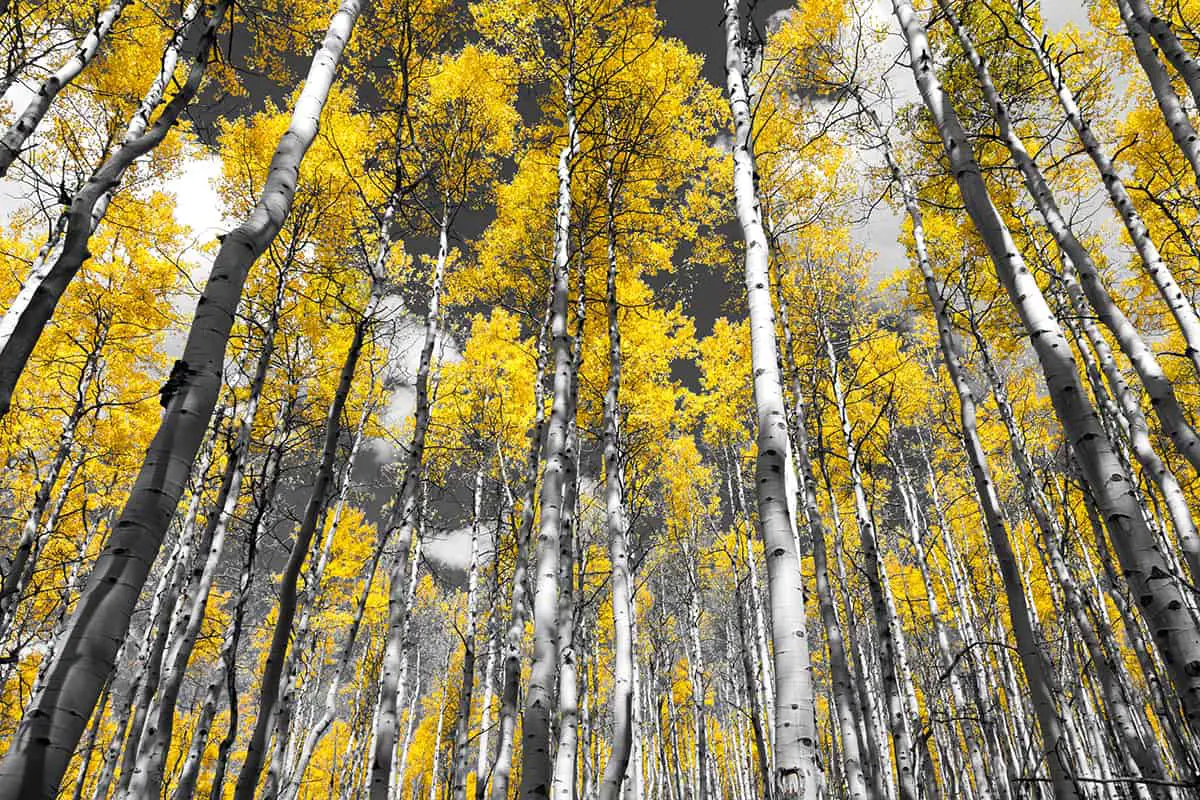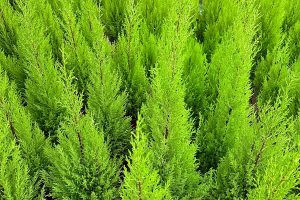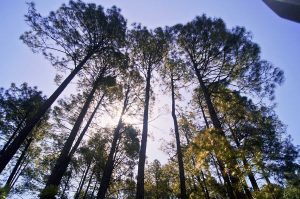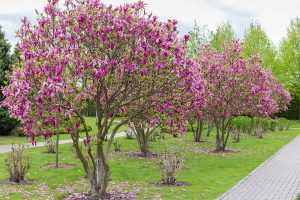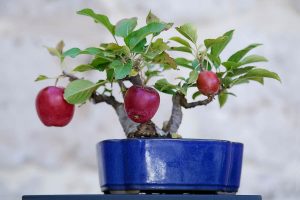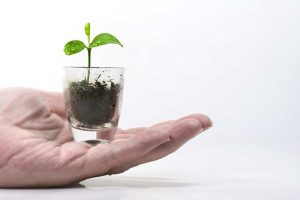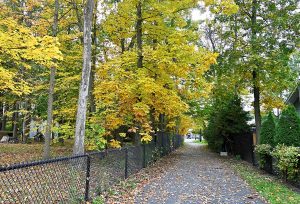Trees with white bark look striking when set against the more earthy tones of the natural landscape, and when the sun shines upon them, they can appear to be almost glowing. Here we take a look at the most sought-after trees with white bark which can be grown in a range of climates and conditions.
Table of Contents
What Types of Trees Have White Bark?
Trees which have white bark include Birch Trees, Aspen Trees, and Gum Trees.
Birch Trees
Birch trees are known for their ornamental attraction, with delicately graceful crowns of foliage which warm up to fiery shades of orange in the fall and pendulous catkins which adorn the branches through fall and winter. One of the most striking things about Birch trees, though, is the interesting colors of their bark.
Birch tree bark comes in a variety of shades, depending on the species. Chinese Red Birch (Betula albosinensis) has salmon-colored bark, while the white bark on the Himalayan Birch (Betula utilis) will exfoliate to reveal dark copper and burnt red shades. Birch trees grow best in full sun or dappled shade, and they can be grown in a range of conditions and climates.
If you live in a hot climate, the River Birch (Betula nigra) is a good option because it is heat tolerant. For a cold hardy birch, choose the Paper Birch (Betula papyrifera) or Silver Birch (Betula pendula), as these are both hard down to USDA hardiness zones 2.
Erman’s Birch
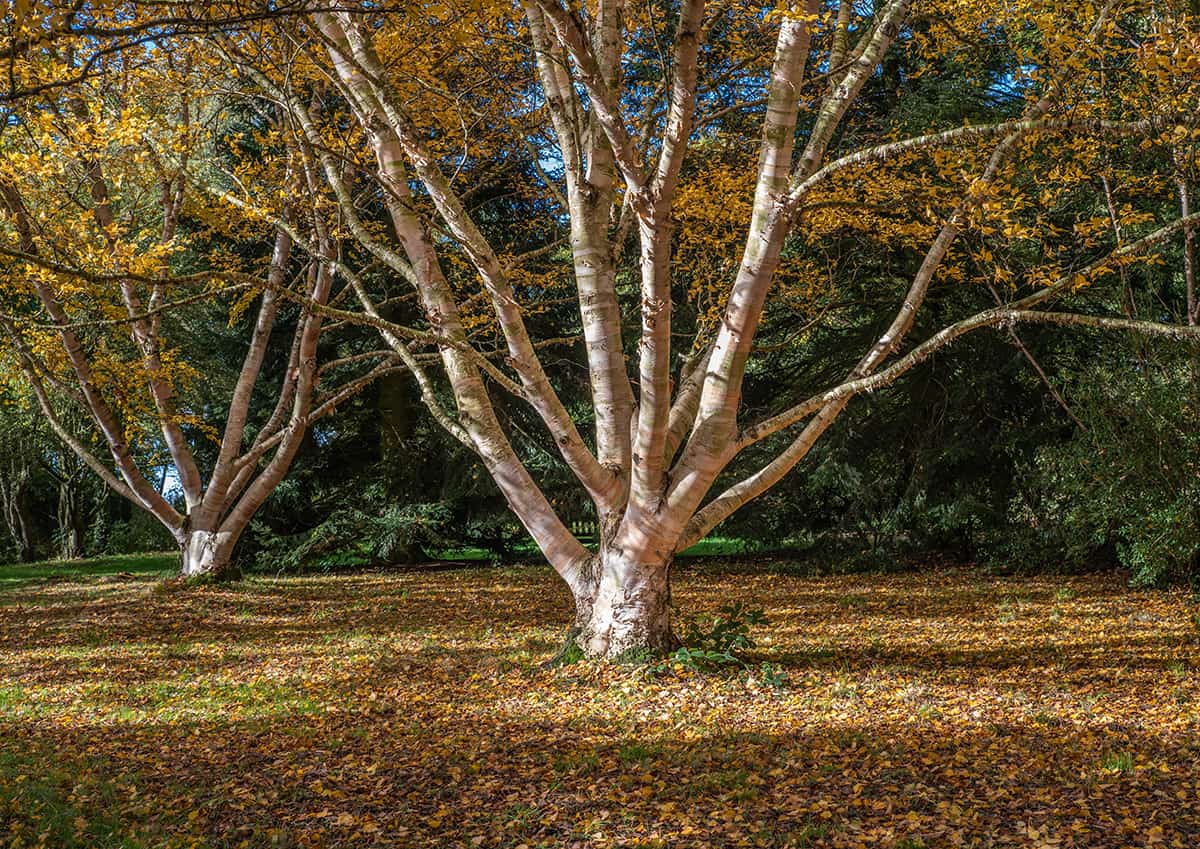
- Botanical name: Betula ermanii
- Common names: Erman’s Birch, Russian Rock Birch, Gold Birch
- Plant family: Betulaceae
- USDA hardiness zone: 5 – 8
- Mature height: 70 feet
- Mature spread: 30 feet
Erman’s Birch is native to much of northern Asia, but it has been largely cultivated across Europe and is now a particularly common sight in public areas and parks in England. This is a mid-sized birch which has a loosely conical canopy.
As a deciduous tree, it sheds its foliage in fall but remains attractive through all seasons thanks to its appealing silhouette and exfoliating bark. The bark is creamy white with subtle flecks of pale pink and peels away in thin ribbons to hang from the tree. The tree grows best in soils that are moderately moist to wet, but it won’t tolerate waterlogged conditions.
River Birch
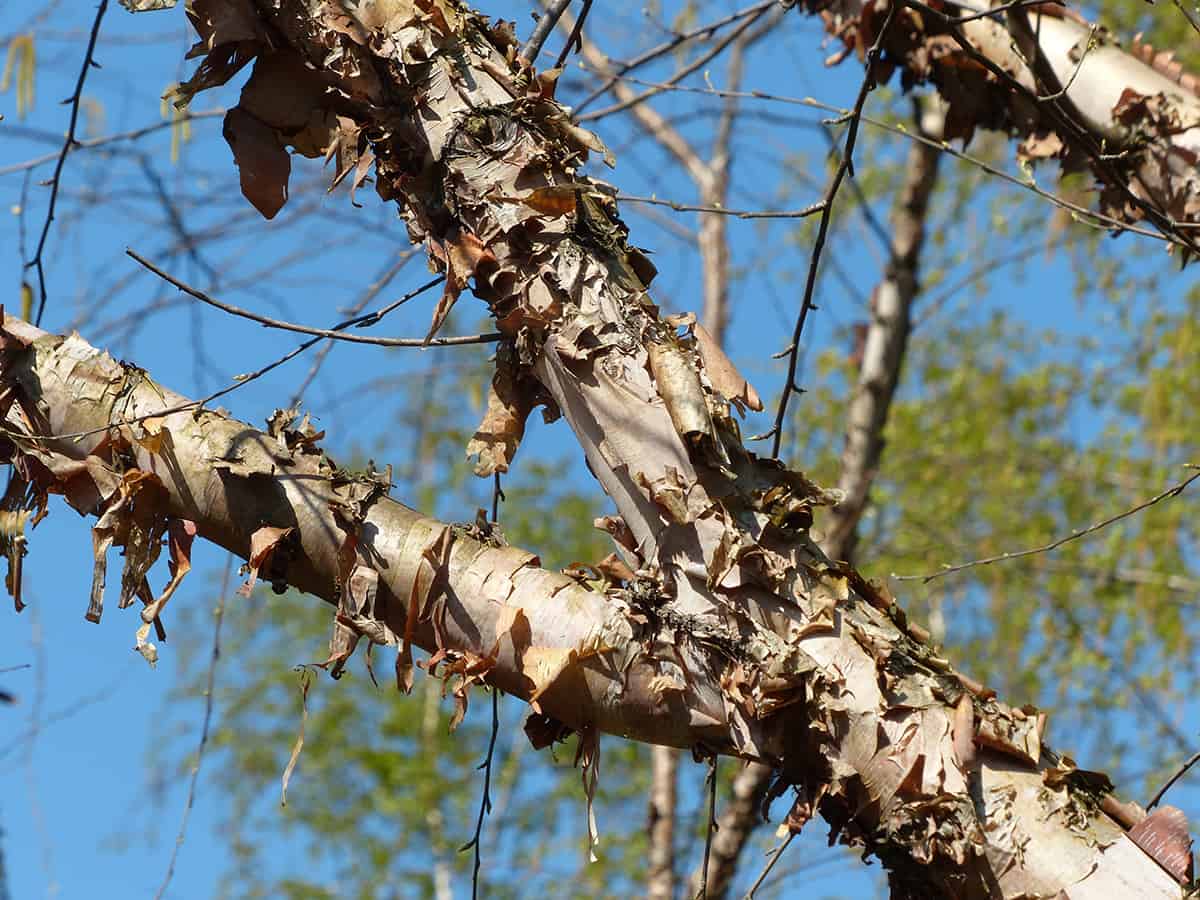
- Botanical name: Betula nigra
- Common names: River Birch, Black Birch
- Plant family: Betulaceae
- USDA hardiness zone: 4 – 9
- Mature height: 70 feet
- Mature spread: 60 feet
The River Birch is a United States native tree, and is among the most heat-tolerant and adaptable trees in the Birch family. It is known for its peeling bark, which starts out pale gray, white, or light salmon in juvenile trees and later develops to warm cinnamon and black. The bark peels away in curling flakes, giving the trunk and branches a heavily textured look.
The canopy takes a pyramid shape, making a good shade tree during the summer months. Foliage is glossy and green on the surface and silver beneath before turning yellow and dropping in the fall. The River Birch can tolerate a wide range of soil types, from dry soils to wet and semi-aquatic conditions.
Paper Birch
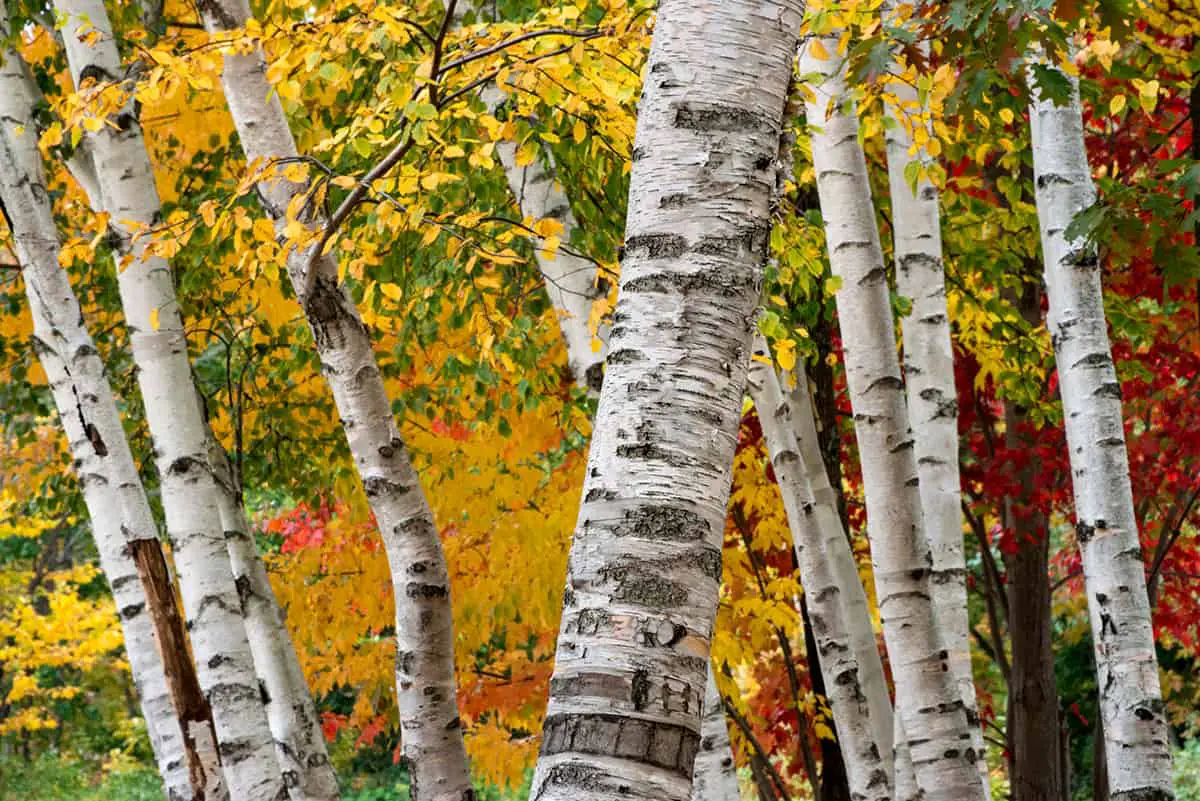
- Botanical name: Betula papyrifera
- Common names: Paper Birch, White Birch, Canoe Birch
- Plant family: Betulaceae
- USDA hardiness zone: 2 – 7
- Mature height: 70 feet
- Mature spread: 50 feet
This is a deciduous tree native to North America. It fares well in cooler climates, where it can live for more than 100 years. It will grow well in USDA hardiness zones six and upwards, but its lifespan will be drastically shortened, at around 30 years. The Paper Birch is named after its bark which peels away from the trunk in sheets that look like paper, and it is believed that these were used to write messages on in years gone by.
In older Paper Birch trees, the bark is so strikingly white that it appears to almost glow, and it will peel away to reveal a cinnamon color beneath. In young Paper Birch trees, the bark takes a reddish brown color. This tree is the state tree of New Hampshire, where it is widely planted as a landscape tree, loved for its bright yellow fall foliage and exfoliating bark. The tree is exceptionally tolerant of cold weather and fares well in snowy climates. It struggles in climates which are humid and hot.
Silver Birch
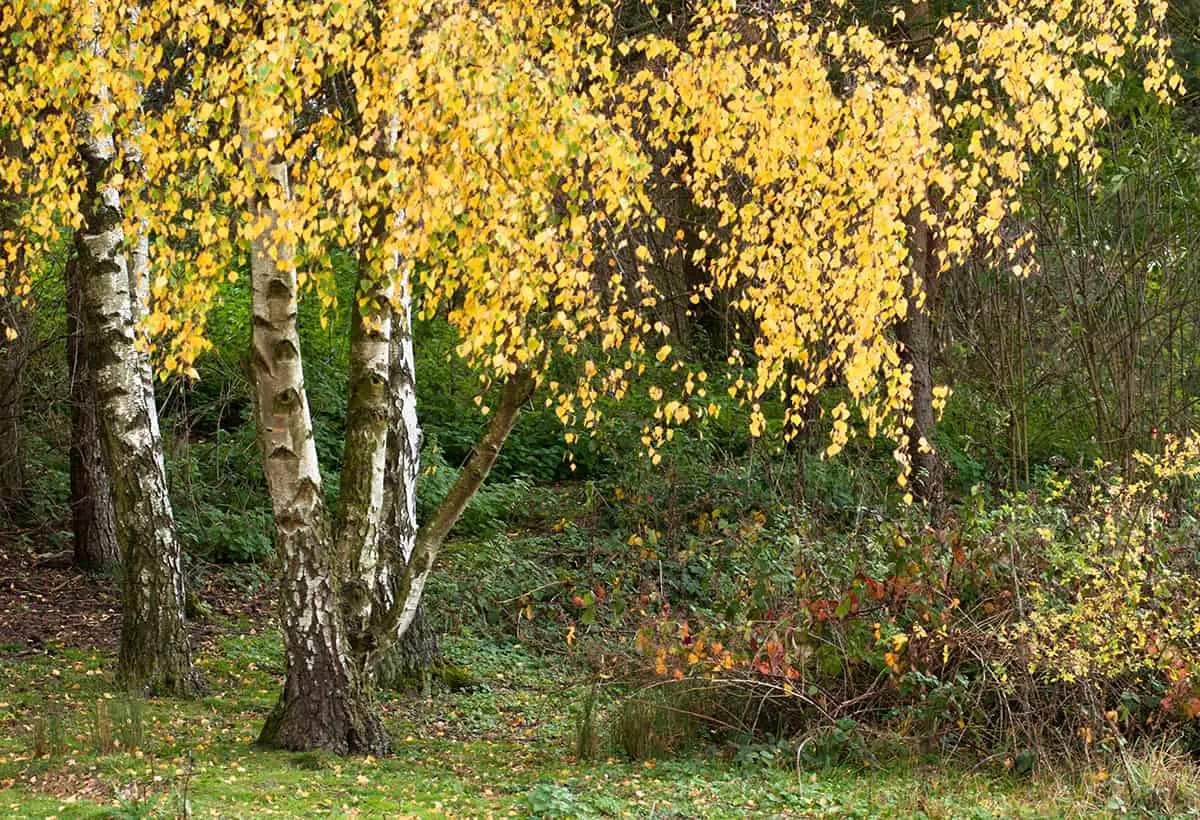
- Botanical name: Betula pendula
- Common names: Silver Birch, European White Birch, Common Birch, Lady Birch, Weeping Birch
- Plant family: Betulaceae
- USDA hardiness zone: 2 – 7
- Mature height: 40 feet
- Mature spread: 30 feet
The Silver Birch is native to Europe and Asia. The small to medium tree produces pendulous branches which give it a weeping look. On juvenile trees, the bark of the trunk and branches is smooth and golden bronze, but on older trees will be white with black markings and can become quite textured and rugged at the base of the trunk.
The tree thrives in full sun or partial shade, and though it prefers moist to wet soils, it can also tolerate periods of drought.
Himalayan Birch
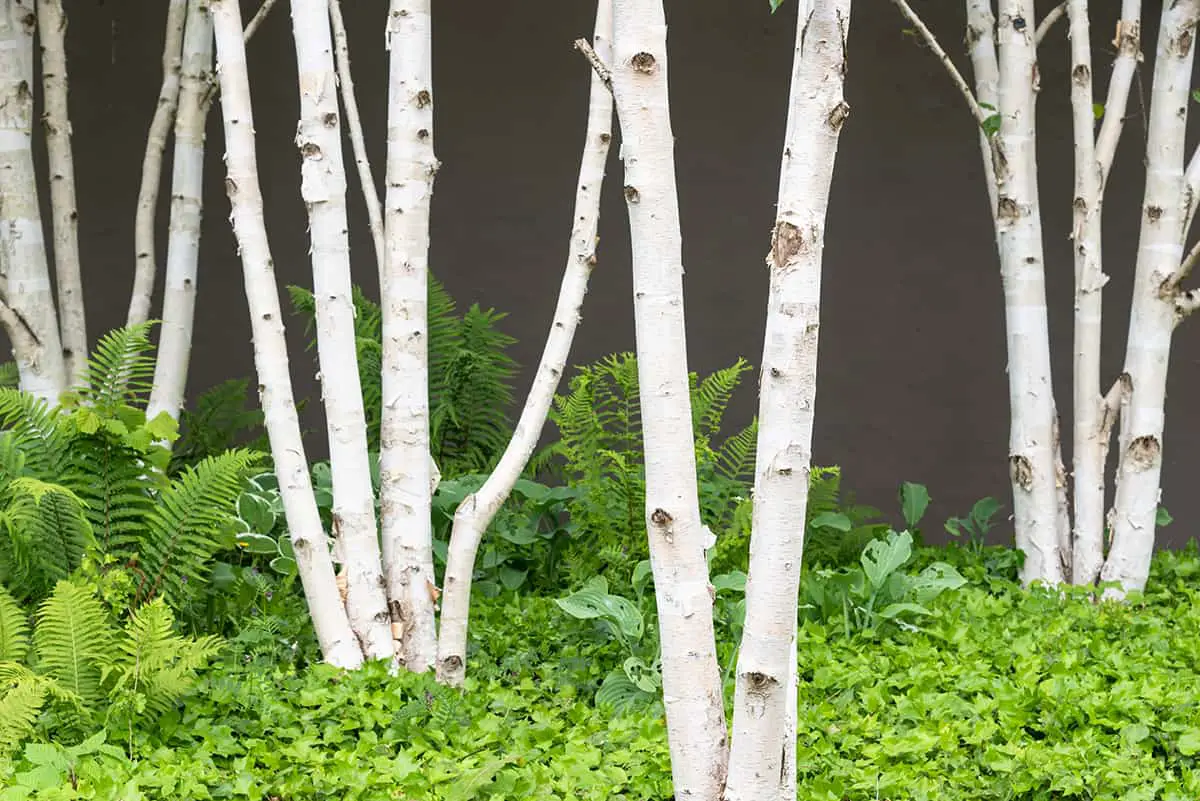
- Botanical name: Betula utilis
- Common names: Himalayan Birch, Kashmir Birch
- Plant family: Betulaceae
- USDA hardiness zone: 4 – 7
- Mature height: 60 feet
- Mature spread: 30 feet
This tree is native to the Himalayas and has a vigorous growth habit that produces gracefully arranged branches to form a pyramid-shaped canopy.
The bark is brown on younger trees, but this soon develops to a glowing white color that appears luminous beneath the rays of the sun. It fares well in cooler climates and prefers low temperatures over heat and humidity. Plant this tree in well-draining soils which are kept moist and cool.
Japanese White Birch
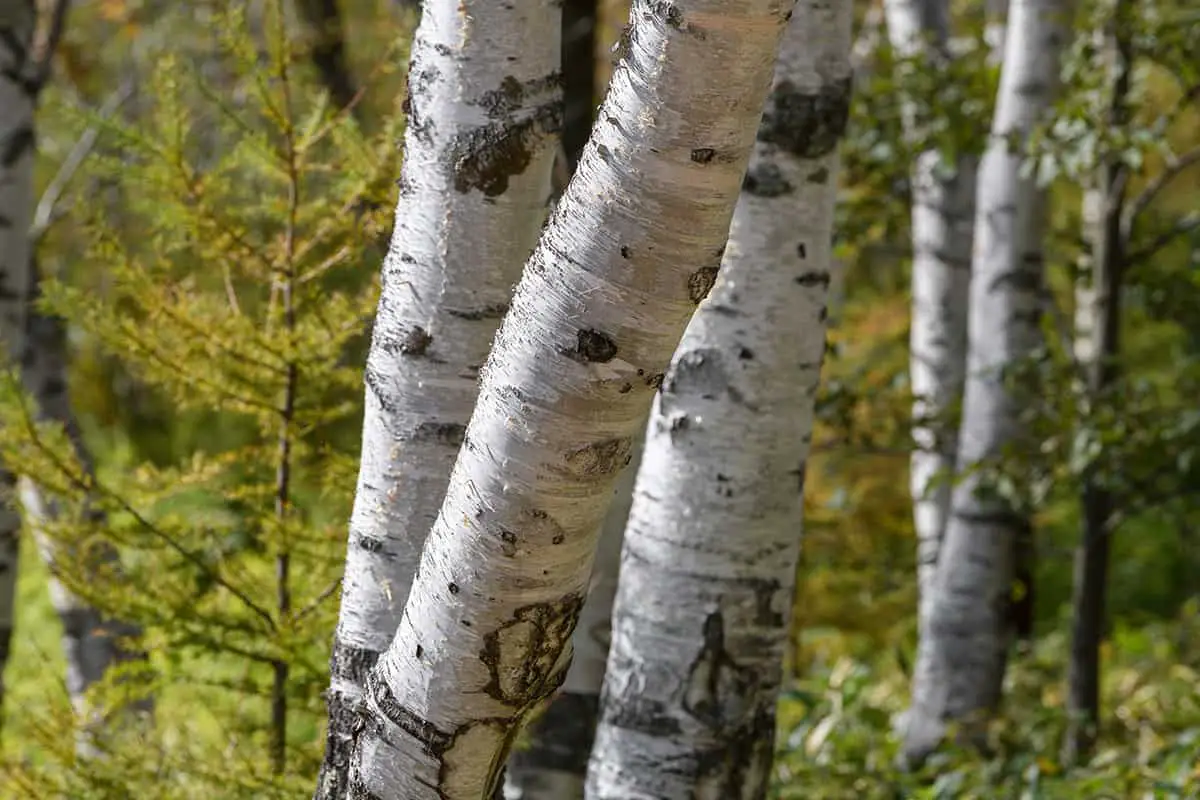
- Botanical name: Betula platyphylla
- Common names: Japanese White Birch, Asian White Birch, White Birch
- Plant family: Betulaceae
- USDA hardiness zone: 4 – 7
- Mature height: 90 feet
- Mature spread: 25 feet
This tree is native to Japan, China, and Korea. It is unusual compared to other types of Birch trees because its bark does not exfoliate. The bark is white with gray markings, covering both the trunk and the elegant branches.
The canopy takes a pyramid shape and is clothed with serrated oval leaves in lime green through summer, which fade to yellow in the fall. This tree grows best in full sun or partial shade in moist, well-draining soils.
Aspen Trees
Aspen trees are native to colder climates around the world, where summers are cool. They are typically medium to large-sized trees, and they all have a deciduous nature whereby they lose their leaves in the fall and produce new foliage the following spring. Aspen trees grow from rhizomatous root systems, which are similar to bulbs.
The rhizomes have a spreading nature, which is why Aspen trees are commonly seen growing in dense forests. You can expect an average colony of Aspens to spread by 3 feet each year. Some Aspen trees can be easily identified by their smooth, white bark, such as the Quaking Aspen (Populus tremuloides), though not all do. The Bigtooth Aspen (Populus grandidentata), for example, has olive green bark, which develops to a gray shade after several decades.
Quaking Aspen
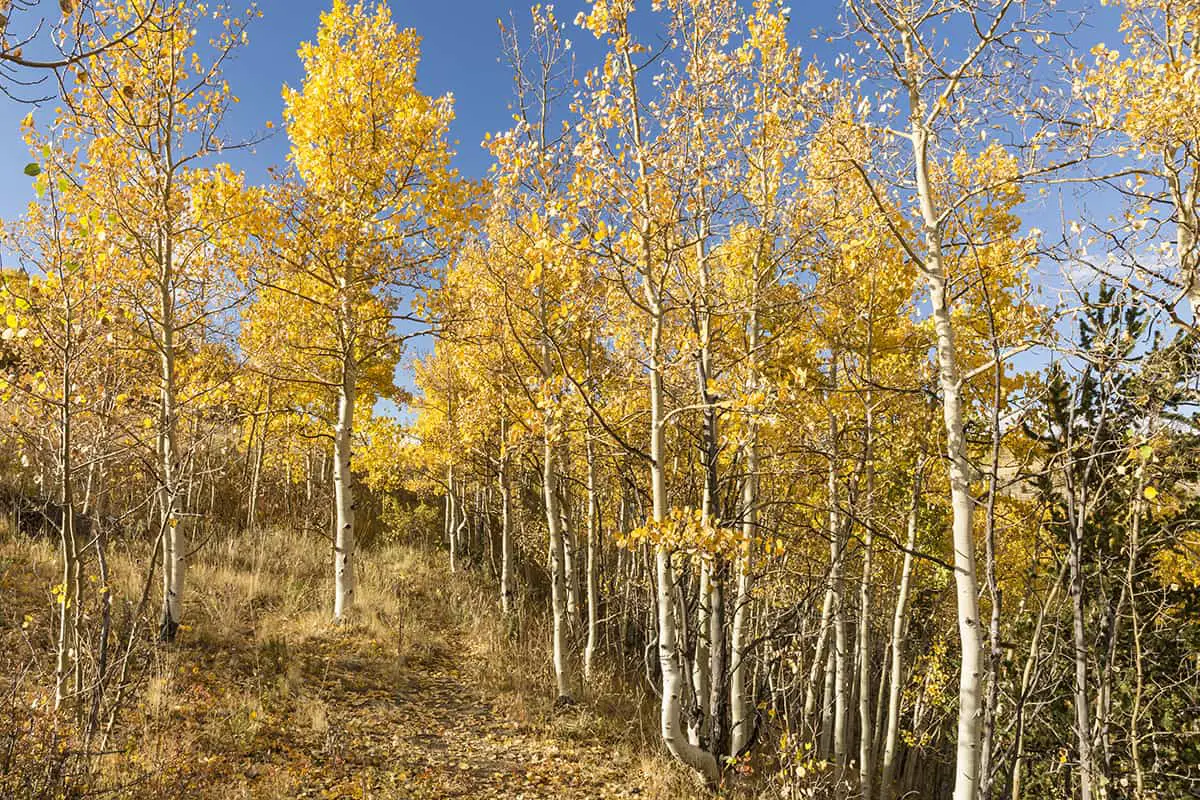
- Botanical name: Populus tremuloides
- Common names: Quaking Aspen, Trembling Aspen, American Aspen, White Poplar, Golden Aspen
- Plant family: Salicaceae
- USDA hardiness zone: 2 – 8
- Mature height: 60 feet
- Mature spread: 30 feet
The Quaking Aspen or Trembling Aspen is so-called because the leaves appear to tremble in the wind due to the flattened petioles which cause the foliage to flutter in the gentlest breeze. These trees are native to North America, where they are widespread, from Mexico and throughout the United States and into Canada.
The bark of the Quaking Aspen tree makes it easy to identify. It is smooth and pale green when young, developing to white as the tree gets older. With age, the white bark will become scarred with black furrows. The leaves of the tree are dark green through summer and take on a bright shade of yellow in the fall. This tree should be grown in full sun, in soil which is moist and well-draining. It has a root system which can be invasive, so it should be planted far from buildings and structures.
European Aspen
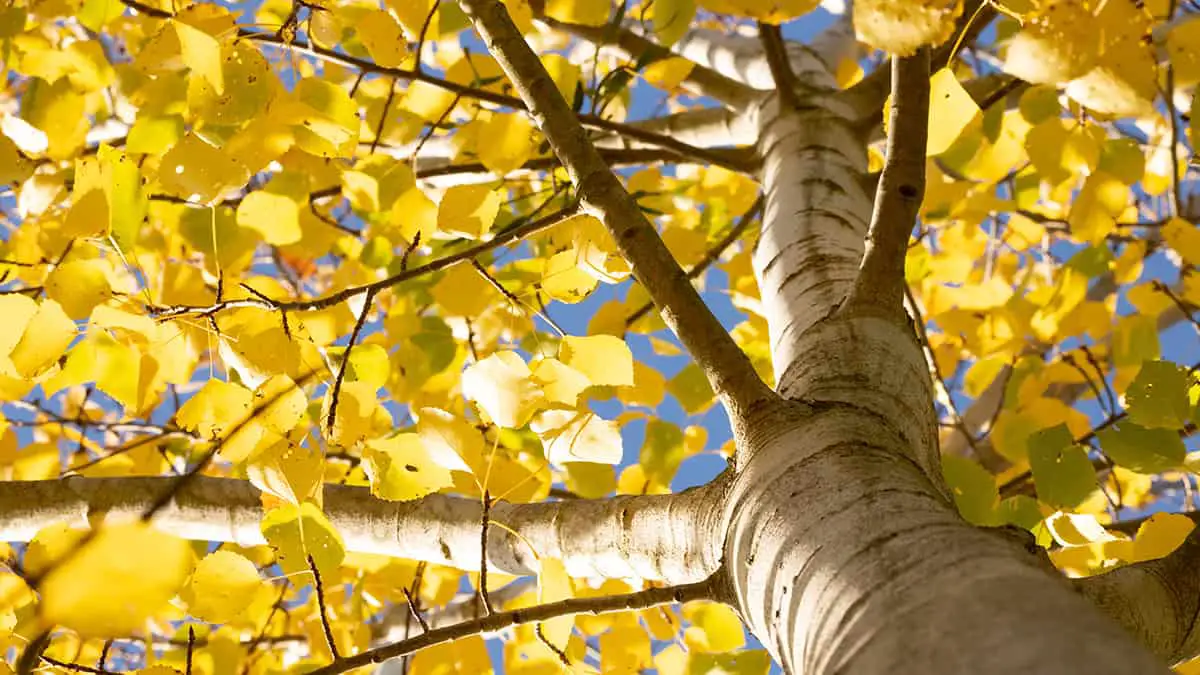
- Botanical name: Populus tremula
- Common names: European Aspen, Eurasian Aspen, Trembling Tree
- Plant family: Salicaceae
- USDA hardiness zone: 2 – 8
- Mature height: 130 feet
- Mature spread: 30 feet
This Aspen tree grows to a great stature of around 130 feet at maturity, with a trunk of approximately 3 feet in diameter. It is native to cooler regions of Europe and Asia, including northern Russia, Scandinavia, Iceland, the UK, Turkey, Japan, and North Korea.
The European Aspen has white bark when young, but this darkens to gray as the tree matures. Like the Quaking Aspen, it is known for its trembling leaves which can be heard rustling in the slightest breeze. It grows in full sun, with well-draining soil which is kept consistently moist.
Gum Trees
Gum trees encompass three genera of trees which all belong to the Myrtaceae family. They are so-called because of their sap which is known to be sticky, like gum. Gum trees are often favored because of their colorful bark which is often exfoliating.
In some trees the bark is white, though it can also feature other colors like pink, blue, green, orange, and red, as is the case with the multicolored bark of the Rainbow Gum (Eucalyptus deglupta).
Mountain Gum
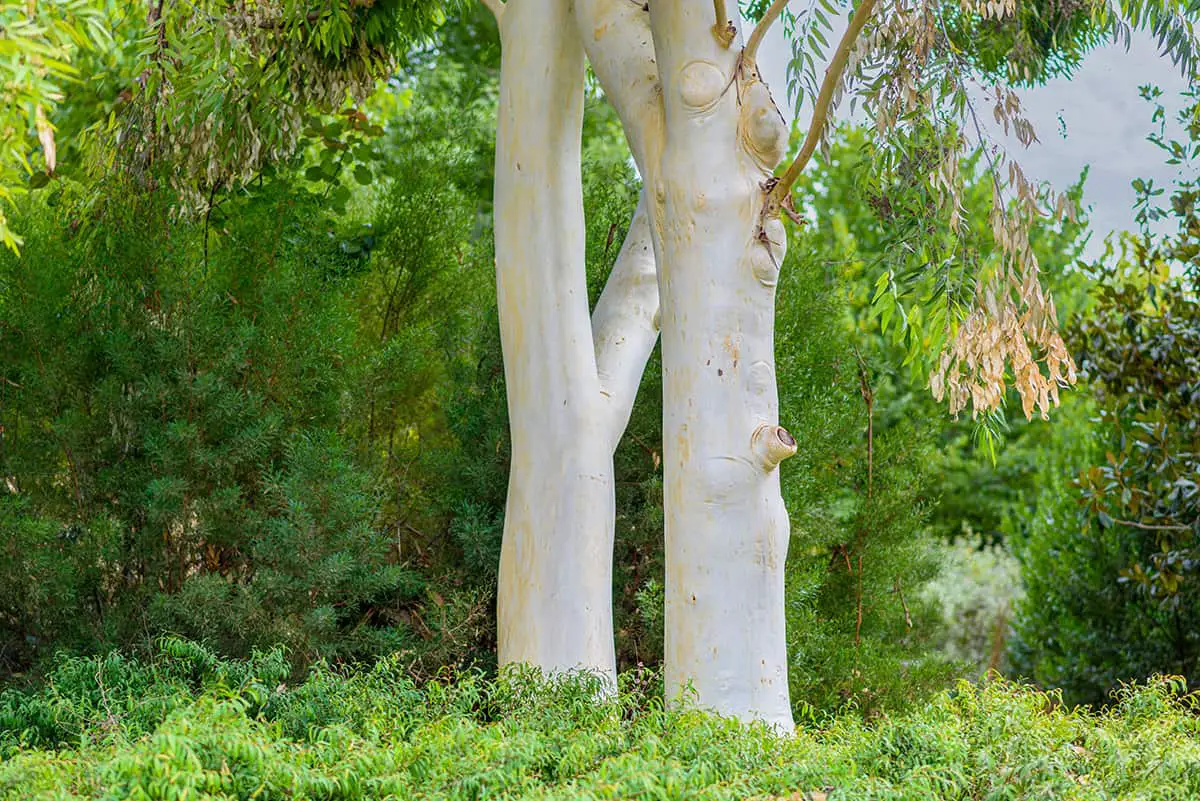
- Botanical name: Eucalyptus dalrympleana
- Common names: Mountain Gum, Monkey Gum
- Plant family: Myrtaceae
- USDA hardiness zone: 8 – 10
- Mature height: 130 feet
- Mature spread: 25 feet
This is a fast-growing evergreen tree which is endemic to Australia. It grows to great heights and maintains a fairly straight trunk which results in a column-like overall shape.
The bark of this tree is very smooth and creamy-white in color. The leaves are dark blue-green and lance-shaped, emitting a strong Eucalyptus scent that is similar to mint. This tree has received the Award of Garden Merit from the Royal Horticultural Society.
Tasmanian Snow Gum
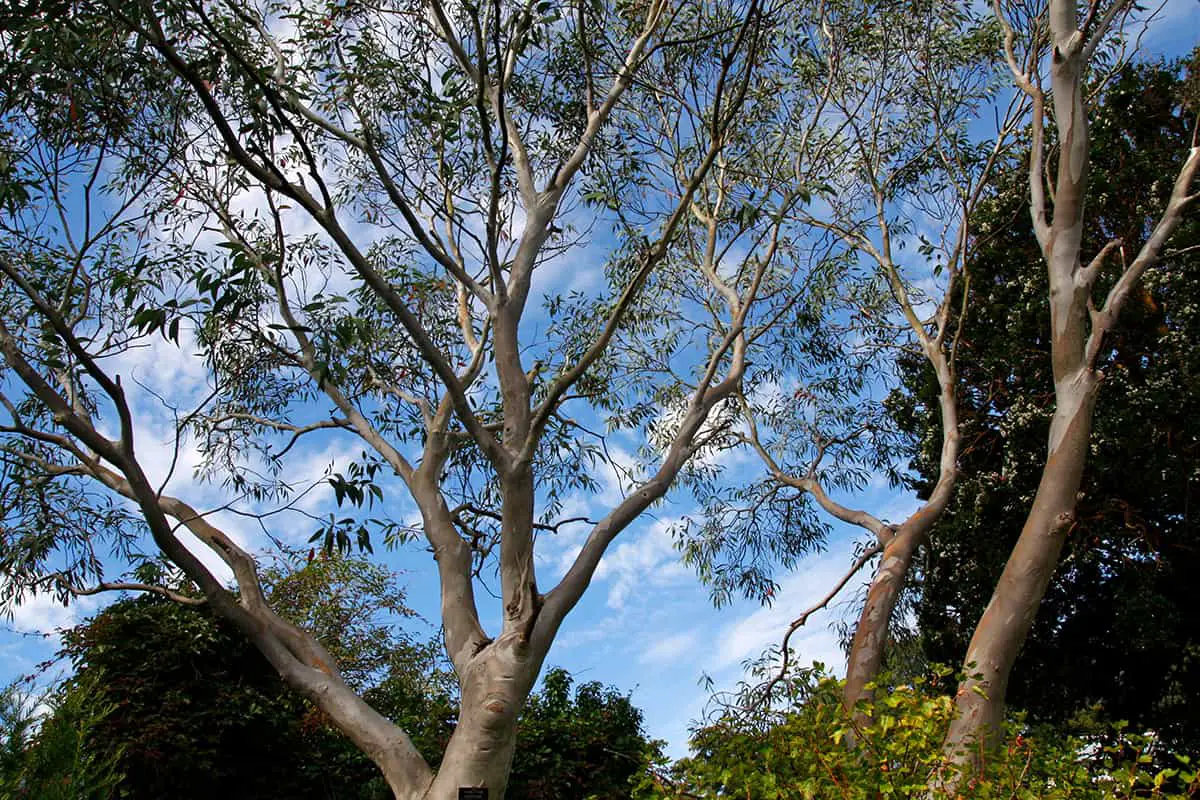
- Botanical name: Eucalyptus coccifera
- Common names: Tasmanian Snow Gum, Mount Wellington Peppermint
- Plant family: Myrtaceae
- USDA hardiness zone: 7 – 10
- Mature height: 80 feet
- Mature spread: 20 feet
The Tasmanian Snow Gum is native to Tasmania. It can be grown as a large shrub or small tree and is one of few species of Eucalyptus which can be grown in a container. This is a highly ornamental species which is loved for its marbled bark and heart-shaped foliage.
The bark of the tree is smooth and mottled, with a mix of streaks in white, gray, and pink. The foliage emerges in bronze but becomes silver-green as it develops. Grow the Tasmanian Snow Gum in full sun, in soil which is consistently moist.
White Gum
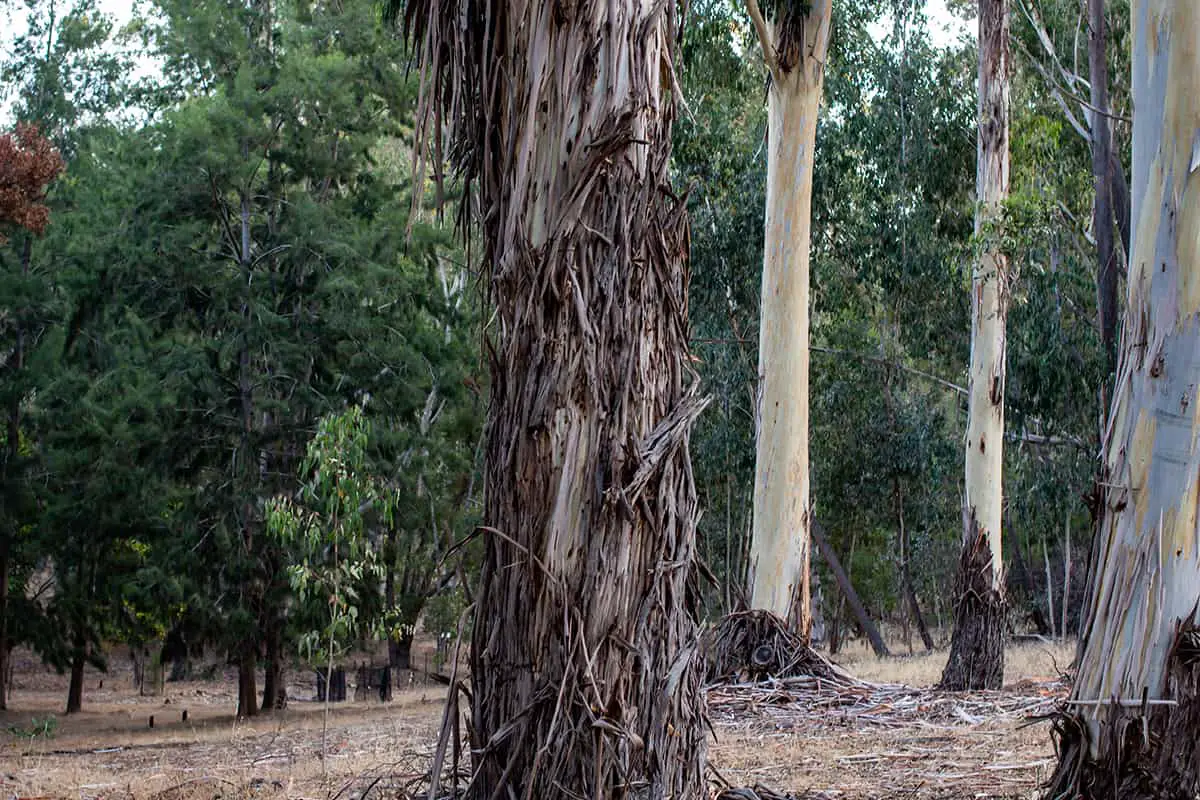
- Botanical name: Eucalyptus rubida
- Common names: White Gum, Ribbon Gum, Candlebark
- Plant family: Myrtaceae
- USDA hardiness zone: 7 – 10
- Mature height: 130 feet
- Mature spread: 50 feet
The White Gum tree is endemic to Australia. It is sometimes known as the Ribbon Gum or Ribbon Tree because the bark peels away in long ribbons and dangles from the trunk and branches.
The outer bark is smooth and white, but it peels to reveal a warm cinnamon shade beneath. This tree prefers moist soil and full sun, but it can tolerate drought.
Lemon-scented Gum
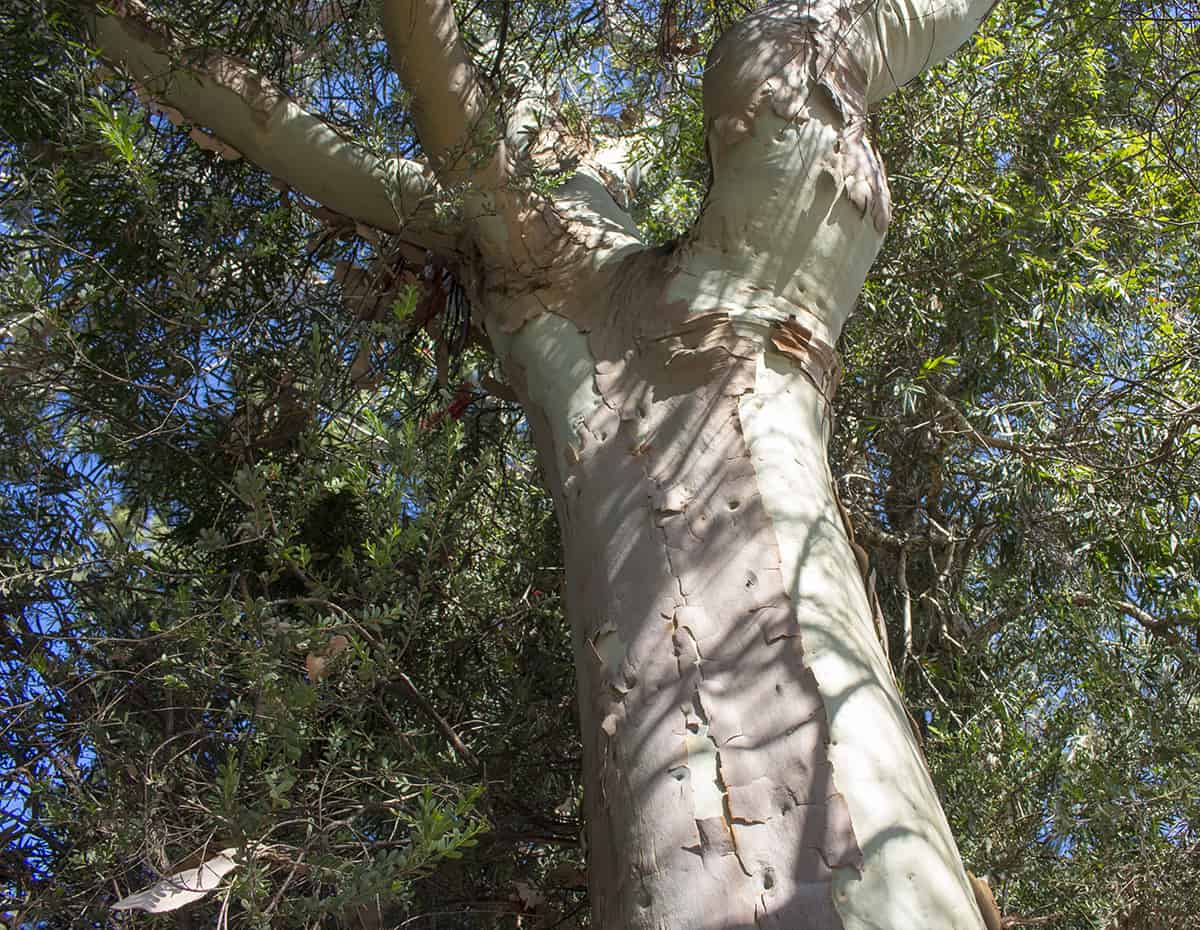
- Botanical name: Corymbia citriodora
- Common names: Lemon-scented Gum, Lemon-Scented Eucalyptus
- Plant family: Myrtaceae
- USDA hardiness zone: 8 – 11
- Mature height: 130 feet
- Mature spread: 50 feet
This tree is endemic to Australia, where it is used to produce citronella oil. The bark of this tree is very smooth in a matte, powdery white color, with occasional flecks of pink or blue.
The bark sheds from the tree in small flakes. It is a long-lived, columnar tree which adds visual and aromatic delight to the landscape. It grows best in full sun and moderate moisture.
